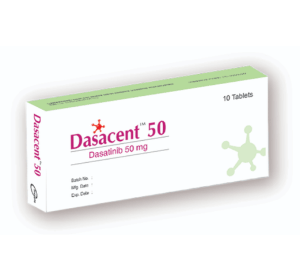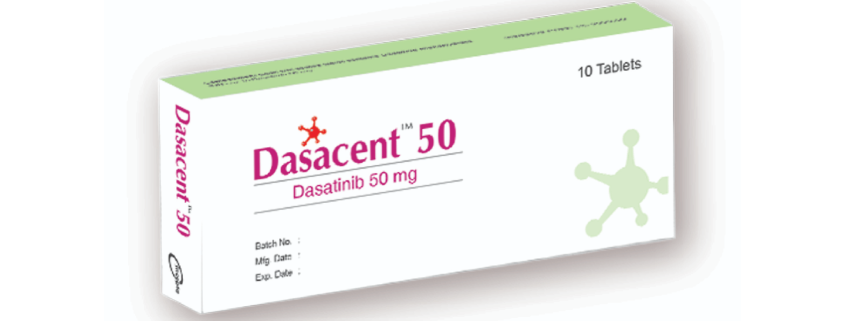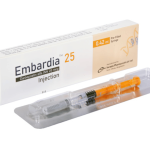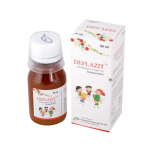Dasacent(Dasatinib)

Therapeutic Group: Kinase inhibitor
Presentation
Dasacentâ„¢ 50: Each film coated tablet contains Dasatinib monohydrate INN eqv. to Dasatinib 50 mg.
Dasacentâ„¢ 100: Each film coated tablet contains Dasatinib monohydrate INN eqv. to Dasatinib 100 mg.
Dasacentâ„¢ 140: Each film coated tablet contains Dasatinib monohydrate INN eqv. to Dasatinib 140 mg
Description
Dasatinib, at nanomolar concentrations, inhibits the following kinases: BCR-ABL, SRC family (SRC, LCK, YES, FYN), c-KIT, EPHA2, and PDGFRβ. Based on modeling studies, dasatinib is predicted to bind to multiple conformations of the ABL kinase. In vitro, dasatinib was active in leukemic cell lines representing variants of imatinib mesylate-sensitive and resistant disease. Dasatinib inhibited the growth of chronic myeloid leukemia (CML) and acute lymphoblastic leukemia (ALL) cell lines overexpressing BCR-ABL. Under the conditions of the assays, dasatinib could overcome imatinib resistance resulting from BCR-ABL kinase domain mutations, activation of alternate signaling pathways involving the SRC family kinases (LYN, HCK), and multi-drug resistance gene overexpression.
Indications
Dasatinib is a kinase inhibitor indicated for the treatment of
• newly diagnosed adults with Philadelphia chromosome-positive (Ph+) chronic myeloid leukemia (CML) in chronic phase
• adults with chronic, accelerated, or myeloid or lymphoid blast phase Ph+ CML with resistance or intolerance to prior
therapy including imatinib
• adults with Philadelphia chromosome-positive acute lymphoblastic leukemia (Ph+ ALL) with resistance or intolerance to prior therapy
• pediatric patients with Ph+ CML in chronic phase
Dosage & Administration
• Chronic phase CML in adults: 100 mg once daily.
• Accelerated phase CML, myeloid or lymphoid blast phase CML, or Ph+ ALL in adults: 140 mg once daily.
• Chronic phase CML in pediatrics: starting dose based on body weight.
• Administer orally, with or without a meal. Do not crush, cut, or chew tablets.
Side Effects
Most common adverse reactions (≥15%) in patients included myelosuppression, fluid retention events, diarrhea, headache,
skin rash, hemorrhage, dyspnea, fatigue, nausea, and musculoskeletal pain.
Precautions
• Myelosuppression and Bleeding Events: Severe thrombocytopenia, neutropenia, and anemia may occur. Use caution if used concomitantly with medications that inhibit platelet function or anticoagulants. Monitor complete blood counts regularly. Transfuse and interrupt DASATINIB when indicated
• Fluid Retention: Fluid retention, sometimes severe, including pleural effusions. Manage with supportive care measures and/or dose modification
• Cardiac Dysfunction: Monitor patients for signs or symptoms and treat appropriately
• Pulmonary Arterial Hypertension (PAH): DASATINIB may increase the risk of developing PAH which may be reversible
on discontinuation. Consider baseline risk and evaluate patients for signs and symptoms of PAH during treatment.Stop DASATINIB if PAH is confirmed
• QT Prolongation: Use DASATINIB with caution in patients who have or may develop prolongation of the QT interval
• Severe Dermatologic Reactions: Individual cases of severe mucocutaneous dermatologic reactions have been
reported
• Tumor Lysis Syndrome: Tumor lysis syndrome has been reported. Maintain adequate hydration and correct uric acid
levels prior to initiating therapy with DASATINIB
• Embryo-Fetal Toxicity: Can cause fetal harm. Advise of potential risk to fetus and avoid pregnancy
• Effects on Growth and Development in Pediatric Patients: epiphyses delayed fusion, osteopenia, growth retardation,
and gynecomastia have been reported. Monitor bone growth and development in pediatric patients
Use in Pregnancy & Lactation
Pregnancy & Lactation: Dasatinib can cause fetal harm when administered to a pregnant woman. It is not known whether Dasatinib is excreted in human milk.
Pediatric Use: The safety profile of dasatinib in pediatric subjects was comparable to that reported in studies in adult
subjects with chronic phase CML. Monitor bone growth and development in pediatric patients.
Geriatric Use: No differences in confirmed Complete Cytogenetic Response (cCCyR) and MMR were observed between older and younger patients.
Drug Interaction
• Strong CYP3A4 Inhibitors: Dose reduction may be necessary
• Strong CYP3A4 Inducers: Dose increase may be necessary
• Antacids: Avoid simultaneous administration
• H2 Antagonists and Proton Pump Inhibitors: Avoid coadministration
Storage
Do not store above 30 degree C. Keep away from light and out of the reach of children.
Commercial Pack
Dasacentâ„¢ 50: Each box contains 1 Alu-Alu blister strip of 10 tablets.
Dasacentâ„¢ 100: Each box contains 1 Alu-Alu blister strip of 10 tablets.
Dasacentâ„¢ 140: Each box contains 1 Alu-Alu blister strip of 10 tablets



